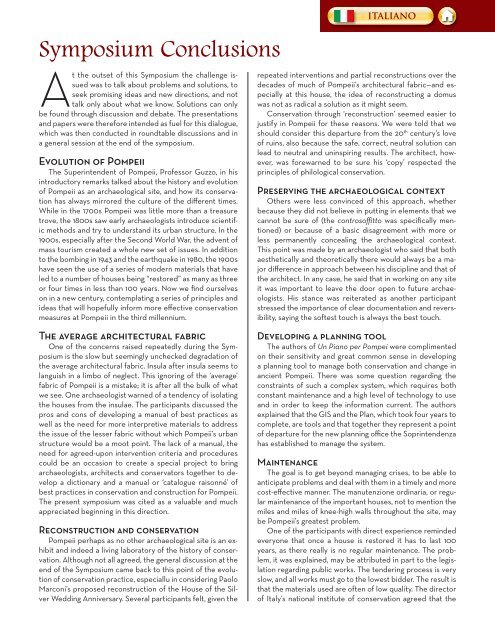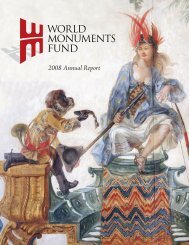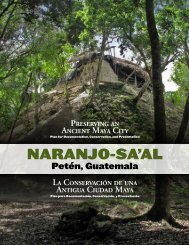Summary of the Proceedings and Papers Presented at - World ...
Summary of the Proceedings and Papers Presented at - World ...
Summary of the Proceedings and Papers Presented at - World ...
Create successful ePaper yourself
Turn your PDF publications into a flip-book with our unique Google optimized e-Paper software.
Symposium Conclusions<br />
At <strong>the</strong> outset <strong>of</strong> this Symposium <strong>the</strong> challenge issued<br />
was to talk about problems <strong>and</strong> solutions, to<br />
seek promising ideas <strong>and</strong> new directions, <strong>and</strong> not<br />
talk only about wh<strong>at</strong> we know. Solutions can only<br />
be found through discussion <strong>and</strong> deb<strong>at</strong>e. The present<strong>at</strong>ions<br />
<strong>and</strong> papers were <strong>the</strong>refore intended as fuel for this dialogue,<br />
which was <strong>the</strong>n conducted in roundtable discussions <strong>and</strong> in<br />
a general session <strong>at</strong> <strong>the</strong> end <strong>of</strong> <strong>the</strong> symposium.<br />
Evolution <strong>of</strong> Pompeii<br />
The Superintendent <strong>of</strong> Pompeii, Pr<strong>of</strong>essor Guzzo, in his<br />
introductory remarks talked about <strong>the</strong> history <strong>and</strong> evolution<br />
<strong>of</strong> Pompeii as an archaeological site, <strong>and</strong> how its conserv<strong>at</strong>ion<br />
has always mirrored <strong>the</strong> culture <strong>of</strong> <strong>the</strong> different times.<br />
While in <strong>the</strong> 1700s Pompeii was little more than a treasure<br />
trove, <strong>the</strong> 1800s saw early archaeologists introduce scientific<br />
methods <strong>and</strong> try to underst<strong>and</strong> its urban structure. In <strong>the</strong><br />
1900s, especially after <strong>the</strong> Second <strong>World</strong> War, <strong>the</strong> advent <strong>of</strong><br />
mass tourism cre<strong>at</strong>ed a whole new set <strong>of</strong> issues. In addition<br />
to <strong>the</strong> bombing in 1943 <strong>and</strong> <strong>the</strong> earthquake in 1980, <strong>the</strong> 1900s<br />
have seen <strong>the</strong> use <strong>of</strong> a series <strong>of</strong> modern m<strong>at</strong>erials th<strong>at</strong> have<br />
led to a number <strong>of</strong> houses being “restored” as many as three<br />
or four times in less than 100 years. Now we find ourselves<br />
on in a new century, contempl<strong>at</strong>ing a series <strong>of</strong> principles <strong>and</strong><br />
ideas th<strong>at</strong> will hopefully inform more effective conserv<strong>at</strong>ion<br />
measures <strong>at</strong> Pompeii in <strong>the</strong> third millennium.<br />
The average architectural fabric<br />
One <strong>of</strong> <strong>the</strong> concerns raised repe<strong>at</strong>edly during <strong>the</strong> Symposium<br />
is <strong>the</strong> slow but seemingly unchecked degrad<strong>at</strong>ion <strong>of</strong><br />
<strong>the</strong> average architectural fabric. Insula after insula seems to<br />
languish in a limbo <strong>of</strong> neglect. This ignoring <strong>of</strong> <strong>the</strong> ‘average’<br />
fabric <strong>of</strong> Pompeii is a mistake; it is after all <strong>the</strong> bulk <strong>of</strong> wh<strong>at</strong><br />
we see. One archaeologist warned <strong>of</strong> a tendency <strong>of</strong> isol<strong>at</strong>ing<br />
<strong>the</strong> houses from <strong>the</strong> insulae. The participants discussed <strong>the</strong><br />
pros <strong>and</strong> cons <strong>of</strong> developing a manual <strong>of</strong> best practices as<br />
well as <strong>the</strong> need for more interpretive m<strong>at</strong>erials to address<br />
<strong>the</strong> issue <strong>of</strong> <strong>the</strong> lesser fabric without which Pompeii’s urban<br />
structure would be a moot point. The lack <strong>of</strong> a manual, <strong>the</strong><br />
need for agreed-upon intervention criteria <strong>and</strong> procedures<br />
could be an occasion to cre<strong>at</strong>e a special project to bring<br />
archaeologists, architects <strong>and</strong> conserv<strong>at</strong>ors toge<strong>the</strong>r to develop<br />
a dictionary <strong>and</strong> a manual or ‘c<strong>at</strong>alogue raisonné’ <strong>of</strong><br />
best practices in conserv<strong>at</strong>ion <strong>and</strong> construction for Pompeii.<br />
The present symposium was cited as a valuable <strong>and</strong> much<br />
appreci<strong>at</strong>ed beginning in this direction.<br />
Reconstruction <strong>and</strong> conserv<strong>at</strong>ion<br />
Pompeii perhaps as no o<strong>the</strong>r archaeological site is an exhibit<br />
<strong>and</strong> indeed a living labor<strong>at</strong>ory <strong>of</strong> <strong>the</strong> history <strong>of</strong> conserv<strong>at</strong>ion.<br />
Although not all agreed, <strong>the</strong> general discussion <strong>at</strong> <strong>the</strong><br />
end <strong>of</strong> <strong>the</strong> Symposium came back to this point <strong>of</strong> <strong>the</strong> evolution<br />
<strong>of</strong> conserv<strong>at</strong>ion practice, especiallu in considering Paolo<br />
Marconi’s proposed reconstruction <strong>of</strong> <strong>the</strong> House <strong>of</strong> <strong>the</strong> Silver<br />
Wedding Anniversary. Several participants felt, given <strong>the</strong><br />
italiano<br />
repe<strong>at</strong>ed interventions <strong>and</strong> partial reconstructions over <strong>the</strong><br />
decades <strong>of</strong> much <strong>of</strong> Pompeii’s architectural fabric—<strong>and</strong> especially<br />
<strong>at</strong> this house, <strong>the</strong> idea <strong>of</strong> reconstructing a domus<br />
was not as radical a solution as it might seem.<br />
Conserv<strong>at</strong>ion through ‘reconstruction’ seemed easier to<br />
justify in Pompeii for <strong>the</strong>se reasons. We were told th<strong>at</strong> we<br />
should consider this departure from <strong>the</strong> 20 th century’s love<br />
<strong>of</strong> ruins, also because <strong>the</strong> safe, correct, neutral solution can<br />
lead to neutral <strong>and</strong> uninspiring results. The architect, however,<br />
was forewarned to be sure his ‘copy’ respected <strong>the</strong><br />
principles <strong>of</strong> philological conserv<strong>at</strong>ion.<br />
Preserving <strong>the</strong> archaeological context<br />
O<strong>the</strong>rs were less convinced <strong>of</strong> this approach, whe<strong>the</strong>r<br />
because <strong>the</strong>y did not believe in putting in elements th<strong>at</strong> we<br />
cannot be sure <strong>of</strong> (<strong>the</strong> contros<strong>of</strong>fitto was specifically mentioned)<br />
or because <strong>of</strong> a basic disagreement with more or<br />
less permanently concealing <strong>the</strong> archaeological context.<br />
This point was made by an archaeologist who said th<strong>at</strong> both<br />
aes<strong>the</strong>tically <strong>and</strong> <strong>the</strong>oretically <strong>the</strong>re would always be a major<br />
difference in approach between his discipline <strong>and</strong> th<strong>at</strong> <strong>of</strong><br />
<strong>the</strong> architect. In any case, he said th<strong>at</strong> in working on any site<br />
it was important to leave <strong>the</strong> door open to future archaeologists.<br />
His stance was reiter<strong>at</strong>ed as ano<strong>the</strong>r participant<br />
stressed <strong>the</strong> importance <strong>of</strong> clear document<strong>at</strong>ion <strong>and</strong> reversibility,<br />
saying <strong>the</strong> s<strong>of</strong>test touch is always <strong>the</strong> best touch.<br />
Developing a planning tool<br />
The authors <strong>of</strong> Un Piano per Pompei were complimented<br />
on <strong>the</strong>ir sensitivity <strong>and</strong> gre<strong>at</strong> common sense in developing<br />
a planning tool to manage both conserv<strong>at</strong>ion <strong>and</strong> change in<br />
ancient Pompeii. There was some question regarding <strong>the</strong><br />
constraints <strong>of</strong> such a complex system, which requires both<br />
constant maintenance <strong>and</strong> a high level <strong>of</strong> technology to use<br />
<strong>and</strong> in order to keep <strong>the</strong> inform<strong>at</strong>ion current. The authors<br />
explained th<strong>at</strong> <strong>the</strong> GIS <strong>and</strong> <strong>the</strong> Plan, which took four years to<br />
complete, are tools <strong>and</strong> th<strong>at</strong> toge<strong>the</strong>r <strong>the</strong>y represent a point<br />
<strong>of</strong> departure for <strong>the</strong> new planning <strong>of</strong>fice <strong>the</strong> Soprintendenza<br />
has established to manage <strong>the</strong> system.<br />
Maintenance<br />
The goal is to get beyond managing crises, to be able to<br />
anticip<strong>at</strong>e problems <strong>and</strong> deal with <strong>the</strong>m in a timely <strong>and</strong> more<br />
cost-effective manner. The manutenzione ordinaria, or regular<br />
maintenance <strong>of</strong> <strong>the</strong> important houses, not to mention <strong>the</strong><br />
miles <strong>and</strong> miles <strong>of</strong> knee-high walls throughout <strong>the</strong> site, may<br />
be Pompeii’s gre<strong>at</strong>est problem.<br />
One <strong>of</strong> <strong>the</strong> participants with direct experience reminded<br />
everyone th<strong>at</strong> once a house is restored it has to last 100<br />
years, as <strong>the</strong>re really is no regular maintenance. The problem,<br />
it was explained, may be <strong>at</strong>tributed in part to <strong>the</strong> legisl<strong>at</strong>ion<br />
regarding public works. The tendering process is very<br />
slow, <strong>and</strong> all works must go to <strong>the</strong> lowest bidder. The result is<br />
th<strong>at</strong> <strong>the</strong> m<strong>at</strong>erials used are <strong>of</strong>ten <strong>of</strong> low quality. The director<br />
<strong>of</strong> Italy’s n<strong>at</strong>ional institute <strong>of</strong> conserv<strong>at</strong>ion agreed th<strong>at</strong> <strong>the</strong>
















